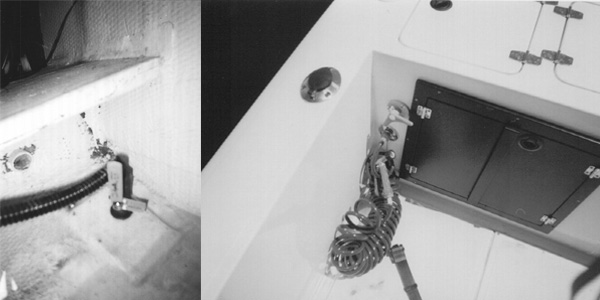
BOAT SMART
HOW TO AVOID SINKING
Capt. Fred Davis
Two of the least checked items on a boat are ones that can lead to major problems - drains and thru-hull fittings. Failure to notice and correct what might seem like a minor item can and often does result in vessels sinking.Many of today’s boats have flush decks said to be self-bailing. A self-bailing deck can be a great feature, but if not checked regularly, can become self-filling. Without your awareness, drains can cause the bilge to fill with seawater, which in turn will be pumped back out of the boat by the bilge pump. That is, assuming you leave the pump in an automatic float controlled “on” position. Some of the new, sophisticated pumps have sensors in place of the float that sense water in the bilge and turn on the pump when water is present. Either of these, float or sensor controlled pumps are excellent as long as the battery does not fail. If you leave your boat at a dock and the battery runs down, unless you have a charger system, you could return to find your vessel sunk.
Running in a choppy sea may also cause a boat to take on water under certain conditions, and by the time you realize what is happening, it could be too late.
Many self-bailing features are designed with drains in the deck, usually near the stern and most often covered by a screen-like cover flush to the deck. Most of these drains are connected by a hose under the flush deck that runs down to the other end that is connected to a thru-hull fitting just above the water line. Some of these thru-hulls, especially those mounted on the stern, are equipped with a flapper or anti-siphon ball. In some installations, problems develop if a low-grade hose is used. Even when a better grade hose is used, cracks can and do occur.
Cracks in the hose allow water - intended to drain out - to drain into the bilge. This causes the bilge pump to cycle frequently, thus draining the battery. Once the battery fails, water drains into the bilge area. As the boat settles a little below the waterline, the thru-hull fittings allow seawater to enter the bilge. and soon the vessel sinks. Once the boat settles to where the pump outlet is located, that too allows water to flow into the boat. The lower the boat goes, the faster the water enters and the sooner the boat will sink completely. If undetected for a few hours, the boat could become a total loss. This problem occurs not only in big boats but smaller boats as well.
Drains at the stern that have a flapper or siphon valve give one a false sense of security. They often get sea growth or leaves and twigs caught in them and if a hose goes bad, the drains will let water flow into the bilge.
When trolling with most of the weight at the stern (fishermen, coolers, tackle), boats with the bilge pump installed too far forward will accumulate a great deal of water between the pump and the stern. I have heard of times when an operator notices his boat handling oddly and when he stopped to check below deck, water rushed forward and flooded the engine causing the boat to stall. In a couple of cases I am aware of, these conditions caused the vessels to sink.Another problem becoming common in small and mid-size boats that also results in sinking is installation of deck wash pumps. These pumps are among some of the greatest additions to boating accessories. They keep the deck clean, allow you to draw a bucket of water or rinse off fish before placing them in the live well. Although many manufacturers are installing deck wash pumps, some with a two-fold use, boat owners also install after market pumps.
Deck wash pumps are often plumbed through a Y valve and used to fill live wells and bait wells. With a Y valve installation, one side of the valve runs to a fill spout then into the live well. Usually there is an overflow pipe in the drain. A quick turn of the Y valve changes the pump pressure to the deck wash, which has a hose fitting, and that hose has a pistol grip type nozzle. The pump itself has a pressure switch that will stop the pump if the water cannot flow freely. Should you leave your vessel unattended with the pump switch in the “on” position, a problem could occur.If a leak develops in a hose connection, the pump can start and stop frequently creating a pulse type pressure on the leaking hose until it breaks. At this time, the pump starts and the water flows freely about the deck and in some cases, into the bilge. Pumped water into the bilge will of course cause the bilge pump to cycle and with two pumps running, the battery will run down quickly and the result once again may be your boat sinking.
Factory installed intake lines normally have a ball valve shut off which can prevent any problem should a hose or fitting break below the waterline. An owner installed deck wash however may be installed without a shut off and this will add to the possible problem.All too often, these pumps are installed with corrugated type hose, which is not as reliable as reinforced, solid hose. I prefer to use the best hose and fittings I can find. A few extra dollars spent could perhaps save your vessel from sinking.
Remember; check all hoses, clamps and fittings below decks every season no matter how hard they are to get at!!
Return to Home Page of Tipsforboating.com